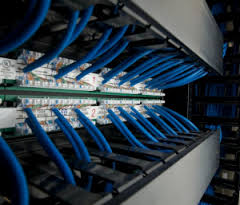10 Points On Structured Cabling
10 Things You May Not Know About Structured Cabling
Structured Cabling is often hailed for making communication and data networks more efficient while substantially reducing the network downtimes. A structured cabling can be defined as a set or system of cabling as well as related hardware that collectively offer a platform for comprehensive telecommunication. This platform fulfils a wide range of purposes, including data transmission and basic telecommunication services.
- Of late, the very idea or concept of Structured Cabling has become quite popular and is used for setting up a cabling structure and communication setup in commercial buildings and large campuses. The set up consists of a series of smaller, standardized components, which can be customized as per customer’s requirements. Often these components are referred as sub systems.
- External cabling gets through a main telecommunication hub called demarcation points. It connects with the other telecommunication housed at different locations inside a building or campus. Each of these smaller compartments is again connected to the main hub through riser cables. Joining the telecommunication system with every work station achieved through horizontal cabling.
- These telecommunication tools are inseparable parts of the structured cabling systems. Majority of the businesses today are connected to their internet service providers with the help of multi-pair cables that converge at the demarcation point, popularly called entrance facility.
- Modern structured cabling system comprises of multiple connection or telecommunication closet, which are again interconnected by cables known as vertical or riser cables.
- Telecommunications Rooms or TRs (as they are popularly called) are situated on the same floor of a high-rise. TRs can also be connected with these riser cables, though these cables do not run between one floor to another. However, two TRs on two different floors cannot be connected with each other by riser cables.
- The place where a network cable is cut off or terminated, is termed as a work area. Thus, anything, which is connected with a network, is termed as a work area component. A work area component includes network outlets, various types of devices like computers and printers, fax machines and telephones, patch cords and so on.
- All these components of a work area, which so far been discussed will be virtually rendered useless, if they cannot be connected to the network and the rooms of telecommunications. This is where the concept of horizontal cabling makes all the difference.
- Horizontal cabling connect the work stations with the network via some devices that include routers, patch panels, switches and so on. All these devices are parts of the TR or Telecommunication Rooms.
- Installation or setting up of the data cabling is taken care of by an internationally accepted and standardized sets of cabling parameters, with the most prominent of them being the EIA/TIA 568-B standard. These stats actually specify the fact that each and every permanent link of the cable that runs from the patch panel to the network device must not be over 90 m long.
- The maximum allowable force that is used at the time of installation of the cables should not be more than 20 ft lb/cable.
About PhoneAM
At Phone America, we have the knowledge and experience to prepare a blueprint for your shift to VoIP. Call us today and we will guide you through the whole process.
Phone America Corporation is a leading supplier of advanced telecom systems for small and large businesses. We serve as a single point of contact for today’s growing communication needs, offering a wide range of telephone equipment, wiring, surveillance systems, telephone cost accounting systems, and voice processing systems.
Call (800) 836-3601 for a free evaluation of your current system and the system you will need to carry your business into the FUTURE.






This post outlines 10 key points about structured cabling, offering a comprehensive overview of its importance and benefits in modern network setups. The author discusses aspects like organization, scalability, and the ability to simplify maintenance and troubleshooting. It highlights how structured cabling supports various technologies, ensures efficient data transmission, and can easily accommodate future upgrades. The article is a valuable resource for anyone considering structured cabling for their business or home network, providing clear insights into why it’s a critical component for reliable and flexible infrastructure.
This blog provides a solid overview of structured cabling, emphasizing its role in ensuring efficient network setups. The clear breakdown of different components and their functions offers valuable insights for anyone considering improvements or installations. Understanding the importance of standards and planning for future scalability is key to a successful cabling system. Great resource for both beginners and professionals looking to enhance their knowledge!
Structured cabling is essential for optimizing network setups and ensuring smooth communication. This article highlights its role in enhancing efficiency, scalability, and ease of maintenance. It also emphasizes how standardized components and proper organization can simplify network management and minimize downtime. It’s a valuable resource for anyone looking to improve their cabling infrastructure, whether for new installations or upgrades.
This article offers an insightful breakdown of structured cabling systems, highlighting their role in streamlining network setups and ensuring efficiency. It emphasizes how well-designed cabling supports scalability, minimizes maintenance challenges, and simplifies troubleshooting, making it an essential component for future-proofing business and home networks. The clear explanation of components and standards provides valuable guidance for anyone considering this type of infrastructure.
This article provides a concise and practical overview of structured cabling, emphasizing its importance for efficient and scalable network infrastructure. The points on cost-effectiveness, organization, and future-proofing are particularly relevant for businesses aiming to stay ahead in tech-driven environments.
Your breakdown of structured cabling essentials highlights how proper planning and organization can significantly improve network performance and scalability. Emphasizing future-proofing and cable management is especially important for businesses looking to minimize downtime and maintenance costs.